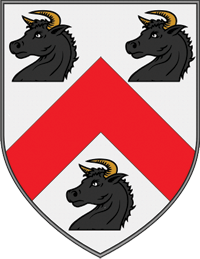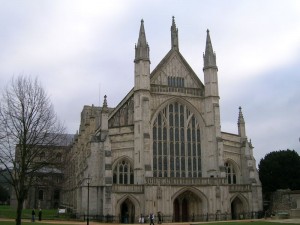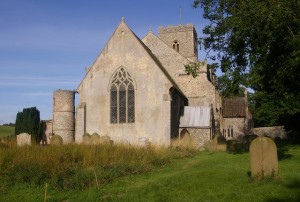I had only just started reading David Loades’ book about the Boleyn family when I had one of those moments… Immediately recognisable, my curiosity was piqued, excitement grew in the pit of my stomach and all because I’d just read something, a tiny morsel of information, that beckoned me to investigate further and embark on another Tudor journey.
In this case it was Loades’ assertion that when Sir James Boleyn died in 1561, ‘with him the direct male line of the Boleyns became extinct’ (pg. 18).
James Boleyn was Thomas Boleyn’s younger brother and was born in c. 1480. He was in his eighties when he died and lived to see his great niece, Elizabeth, ascend the throne in November 1558. A few years later, he left a number of things to her in his will (Loades, pg. 18).
James was Anne Boleyn’s chancellor and his wife, Elizabeth Wood, Lady Boleyn, ‘served’ Anne during her imprisonment in the Tower and was one of the four ladies that accompanied her to her death in May 1536 (Ives, pg. 357).
But before we delve any further into the life of James Boleyn it is necessary to divert a little…
If I had read this five years ago, I would have accepted it without questioning. I used to read non-fiction from start to end, generally not taking any notice of the notes, happily assuming that the person writing the book was always correct. Well, it was published and non-fiction after all, must be accurate right?
I have of course since learned that this is not always the case and I now regularly refer to the notes section and always check the bibliography for interesting primary and secondary sources.
Back to James, after further investigation I found that there were another two Boleyn brothers that lived to adulthood, William and Edward Boleyn (Griffiths, pg. 454) making that four surviving sons of Lady Margaret Butler and Sir William Boleyn: Thomas, James, William and Edward.
Unfortunately, I found no mention of either William or Edward in Loades’ book and any information I found about William on the internet was contradictory.

Frontispiece, 1805 quarto edition of An Essay Towards a Topographical HIstory of the County of Norfolk, Vol. I.
Francis Blomefield in ‘An essay towards a topographical history of the county of Norfolk’ volume 6 states: ‘William, archdeacon of Winchester, died without issue, and was buried at Blickling, December 18, 1571’.
Various online genealogy websites followed suit by stating that William had died in 1571. This date is also used in the Boleyn family tree published in Elizabeth Griffith’s fantastic article about the Boleyns at Blickling and appears in The Boleyn family tree on page 321 of Alison Weir’s biography on Mary Boleyn. I was now determined to find out who in fact had been the last Boleyn – James or William?
I contacted a very knowledgeable friend and researcher, Lauren Mackay, who accessed a PhD about Thomas Boleyn that stated that William had died in October 1551 and on this occasion the source was listed – hooray!
My next step was to follow this lead to the register of the University of Cambridge. Here a quick search revealed that William, among other things, had in fact been archdeacon of Winchester until his death in 1551 but perhaps most excitingly, that he was buried at Stiffkey in Norfolk.
I was delighted to now have a location to investigate!
I proceeded to find out what I could about Stiffkey, a village on the north coast of Norfolk, and learnt that at the east end of the village is its church, St John the Baptist and that in the churchyard is the remains of another church, St. Mary’s. Behind the church is the sixteenth century Stiffkey Hall.
Whilst researching the churches, I found out some interesting information. It was unusual to have two churches in one churchyard but apparently more common in Norfolk than anywhere else in England. There remained two churches at Stiffkey until they were officially united by the Bishop of Norwich in 1563, after which one was deconsecrated and fell into disrepair. It was always thought that St. John’s was the church that had survived and remains until this day but ‘some authors have asserted that it is St John’s church which has gone, implying that St Mary’s survived and that at some time in the past the dedication has been changed.’ (St John & St Mary Stiffkey)
I also came across this information detailing the various Lords of Stiffkey Manor:
“John Hasham presented as lord in 1413; and Sir Hugh Halsham dying lord in the 20th of Henry VI. and having no issue by Petronilla his wife, this lordship came to Joan, daughter and heir to his brother, Richard HalshamI wife of John Lewkenor, Esq. from whom it came to Sir Jeffrey Boyleyne, Knt. and Lord Mayor of London, in 1457, whose son, Thomas Boleyn, presented to St. Mary’s church in 1461, and 1463, as did Will. Boleyn, Esq: his brother, in 1474, &c. and Sir James Boleyne in 1542.”
This connection between the Boleyns and the local manor and church made me confident that I was on the right track.
A few days later I received an email from the incredibly helpful staff at the Norfolk Record Office who checked the Stiffkey parish registers and confirmed that William Bulleyn was buried 6 February 1552 (new style) and also that he was the archdeacon of Winchester. The researcher also mentioned that the entry is quite faint and the rest of the text illegible. This might account for the confusion with the date.
If you’re wondering about the ‘new style’ reference, a Tudor person writing about William’s death might have recorded it as 6 February 1551 because the Tudor new year did not commence until March 25 and remained this way in England until 1752. So what is February 1552 to us is February 1551 to a Tudor person. Thank you to Suzannah Lipscomb for helping me get my head around this!
The October 1551 date given in the entry about William in the University of Cambridge register is a bit of a mystery. William died some time before he was buried but four months before sounds highly unlikely!
So now with William out of the picture so to speak, I was left with one more brother – Edward.
Sadly, it was difficult to find any information about Edward and no date for when he died. Online genealogy websites list him as dying some time before 1536.
Blomefield states that,
‘Sir Edward Boleyn, Knt. of Blickling, married Anne, daughter and coheir of Sir John, son of Sir Robert Tempest, Knt. and Catherine his wife.’ (Read the entry here)
We know then that he was knighted and married Anne Tempest but we don’t know when he died or where he is buried apart from the reference to it being pre 1536. I found no further clues by looking for information about the death and burial of his wife Anne, as her final resting place, as far as I can see, is also unknown.
In Feet of Fines of the Tudor period [Yorks]: part 1: 1486-1571 Edward is named in an entry dated 1531 and in January 1531 is granted ‘Custody of the possessions of Roger Appleyard, deceased; with wardship of John, s. and h. of the said Roger’ (Letters & Papers).
He is then mentioned in an entry dated January 1536,
Declaration by Ric. Redmayne of the money received by him out of the study of the late bishop of Norwich, from the 12th Nov. 27 Hen. VIII. to 4 Jan. following:—
Total receipt, 2,331l. 16s. 11d., whereof he accounts for 1,576l. 5s. 10d. Among the persons mentioned in the account are Ric. Bellamy, Wm. at Mere, the Bishop’s receiver, and Wm. Newton, late receiver; Robt. Frank, farmer of Terlyng; the duke of Norfolk, Mr. Redcliffe, the Bishop’s godson; John Beale, who had married a kinswoman; Mrs. Rochester, of Terlyng, a kinswoman; Sir E. Boleyn, Robt. Bate, a kinsman; Master Winter, archdeacon of— (fn. 2) Thos. Sakforde, alms to various poor persons, amounting to 133l. 3s. 7d. &c.
Pp. 3. Endd. by Southwell: To be delivered unto Mr. Secretary.
I could find no other mentions of Sir Edward Boleyn after 1536.
James Boleyn and Elizabeth Wood did not have any children that survived, William Boleyn died without issue, Edward Boleyn and his wife had daughters, and Thomas Boleyn, well, we all know what became of Thomas and Elizabeth’s children – Mary, Anne and George…
Although Thomas Boleyn is the most famous of the four Boleyn siblings, the direct line of the male Boleyns did indeed end with the death of James Boleyn.
In part 2 I will look at what we know about the life of Sir James Boleyn.
ReferencesGriffiths, E. The Boleyns at Blickling, 1450-1560 (Norfok Archaeology, 40, 2009).
Ives, E. The Life and Death of Anne Boleyn, 2004.
Loades, D. The Boleyns: The Rise and Fall of a Tudor Family, 2011.
Weir, A. Mary Boleyn: ‘The Great and Infamous Whore’, 2011.
Cambridge Alumni Database
‘Hundred of South Erpingham: Blickling’, An Essay towards a Topographical History of the County of Norfolk: volume 6 (1807), pp. 381-409. URL: http://www.british-history.ac.uk/report.aspx?compid=78270&strquery=Edward Boleyn Date accessed: 23 March 2012.
‘Yorkshire Fines: 1531-35’, Feet of Fines of the Tudor period [Yorks]: part 1: 1486-1571 (1887), pp. 58-73. URL: http://www.british-history.ac.uk/report.aspx?compid=49626&strquery=Edward Boleyn Date accessed: 23 March 2012.
‘Henry VIII: January 1531, 16-31’, Letters and Papers, Foreign and Domestic, Henry VIII, Volume 5: 1531-1532 (1880), pp. 22-37. URL: http://www.british-history.ac.uk/report.aspx?compid=77451&strquery=Edward Boleyn Date accessed: 23 March 2012.
‘Henry VIII: January 1536, 11-15’, Letters and Papers, Foreign and Domestic, Henry VIII, Volume 10: January-June 1536 (1887), pp. 26-38. URL: http://www.british-history.ac.uk/report.aspx?compid=75410&strquery=Sir Edward Boleyn Date accessed: 23 March 2012.
http://www.tudorplace.com.ar/BOLEYN.htm
http://www.northnorfolkimages.co.uk/location/stiffkey.html
http://www.northnorfolkcentral.co.uk/balestiffkey/stiffkey/Blomefield%20Stiff.html



















That was very interesting Natilie, great research, and really looking forward to your next part. I am also in the middle of reading Loades book on the Boleyns, and would have taken what he said as right, in this anyway, goes to show that everything that is written, even by the experts is not always correct.
So glad you enjoyed it Dawn! Thank you for taking the time to leave a comment – I really appreciate it Natalie
Natalie
I love reading about the Boleyns and cant wait to read “The Lady in The Tower: The Fall of Anne Boleyn” by Alison Weir after hearing the review on The Book Report, go check it out – http://www.bookreportradio.com
Hi Nancy, the Boleyns fascinate me too! I have read Alison’s book and enjoyed it very much. Thanks for dropping by! Natalie
Fascinating! Looking forward to reading part 2.
Lovely to hear from you Susan! Glad you enjoyed the article Natalie
Natalie
Hi Just wondering if you have any info on Edward and Anne Bolyen’s daughters especially an Elizabeth. Thanks.
The male line may have died out, but the female line did not. I know, I know, it’s a man’s world I recently discovered in researching my own ancestry that I am descended from Bridget Heydon, daughter of Ann Elizabeth Boleyn and Henry Heydon. Ann Elizabeth Boleyn being the daughter of Sir Geoffrey Boleyn II and Lady Ann Hoo. Forgive me if I got the names wrong as I am doing this from memory! It was a pleasant surprise for me as I have always loved this time in history. I have loved looking over your site and cannot wait to read some of the books that you have mentioned!
I recently discovered in researching my own ancestry that I am descended from Bridget Heydon, daughter of Ann Elizabeth Boleyn and Henry Heydon. Ann Elizabeth Boleyn being the daughter of Sir Geoffrey Boleyn II and Lady Ann Hoo. Forgive me if I got the names wrong as I am doing this from memory! It was a pleasant surprise for me as I have always loved this time in history. I have loved looking over your site and cannot wait to read some of the books that you have mentioned!
I found the article helpful and useful for my own researches into the possible origins of my own Boleyn ancestor Anna Newcomen c1606 – 1690 (nee Bullein and possibly the ‘real’ last Boleyn) spouse of Sir Robert Newcomen 4th Baronet 1596 – 1677. She is referred to in many genealogies as grand-niece and near kinswomen of Queen Elizabeth I, blood relative of Anne Boleyn etc.
Web References I’ve found and the discussion I launched are at:
http://www.theanneboleynfiles.com/forum/anne-boleyn-forum/anna-bullein-spouse-of-sir-robert-newcomen-4th-baronet-and-kinswoman-of-anne-boleyn/#p21307
She is, in some references, thought to be sister (though I think more likely cousin) to the sisters Mary and Elizabeth Bullyn, whose tombstone found near Clonony Castle in Ireland, claims ancestry back to George Boleyn Viscount Rochford.
FYI There are a couple of interesting articles on the Bullyn sisters tomb at:
https://archive.org/stream/anecdotesaristo02burkgoog#page/n252/mode/1up/ and
https://archive.org/stream/jstor-25497775/25497775#page/n5/mode/1up/search/Bullyn
Read more: http://www.theanneboleynfiles.com/forum/anne-boleyn-forum/annes-cousins-at-clonony-castle-in-ireland/page-4/#ixzz2sUlExF5a
In case the tomb inscription is inaccurate (though I sense its claims should not be dismissed lightly) I am searching also for other possible ancestors of Anna, Mary and Elizabeth, hence my interest in your article.
Lastly the following link may be a reference to William Boleyn as a younger man and I would be interested if this was correct or otherwise?
http://newton-le-willows.com/?page_id=417
Kind regards,
Jeff Angus
Enjoyed your article. I am a descendant of Sir Edward and his wife Anne Tempest through their daughter Elizabeth who married Thomas Payne of Itteringham. I’ve been trying to find more information of Sir Edward. Thanks.
Hello Kelly,
I would be interested in corresponding with you and sharing research notes as I have been researching this line of the Payne family too. Although I have not found positive proof yet, I am confident that my ancestral trail leads to this family from my earliest known ancestor, Thomas Payne (d. 1673) who married Jane Smallpiece. If you have been researching this family, you are likely aware of the intermarriages that include families such as the JERMYN and DUKE’s, as well as the SMALLPIECE family of Norwich. Beyond this, I have managed to add several pieces of circumstantial evidence connecting my Thomas to this Payne family, but they unfortunately did not leave many primary records behind to confirm the relationship. But I keep digging!
Thanks for sharing.
Patrick – My descent is as follows:
14th GGP Thomas Payne m. Elizabeth Boleyn (Itteringham, Norfolk)
13th GGP Mary Payne m. William Reymes (Overstrand, Norfolk)
12th GGP William Reymes m. Anne Evans
11th GGP John Reymes m. Frances unknown
10th GGP Unnamed daughter Reymes m. Rev. Nathaniel Brewster (Alby, Norfolk but died in Long Island,
New York, USA; mentioned in J. Reymes LWT of 1662)
9th GGP Sarah Brewster and Jonathan Smith (of Long Island, New York)
8th GGP Abigail Smith m. Rev. Isaiah Harrison (of Long Island, NY; Sussex, DE; and Shenandoah, VA)
7th GGP Joseph Harrison m. unknown (
6th GGP Joseph Harrison (b. abt 1730) m. (30 Jun 1762) Anne Boles/Bawls
5th GGP Martha Harrison m. Joshua Davis (Wilkes, North Carolina)
4th GGP Elijah Davis m. Anna Uriah Stephenson
3rd GGP John N. Davis m. Mary Jane Steelman
2nd GGP George B. Davis m. Emma Spratt (Tazewell, Virginia)
1st GGP Paul Davis m. Lena Meryl Elkins (Tazewell, Virginia)
GP Jeanne Davis m. G. Haynes
Parent: R. Haynes m. K. Young
K. Haynes m. E. Green (Annapolis, Maryland)